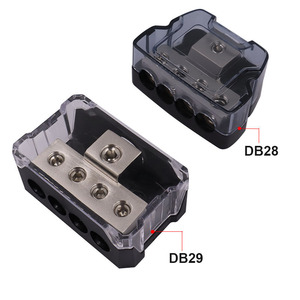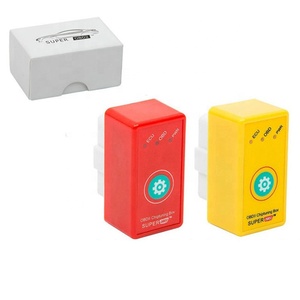Types of Chip Tuning Box
A chip tuning box is an electronic device that connects to a vehicle's engine control unit (ECU) to improve performance. It contains prewritten software that adjusts various settings in the ECU, such as fuel delivery and turbo boost pressure. This optimizes the engine's performance without replacing any physical parts.
OBD Tuning Box
These user-friendly devices connect through the vehicle's OBD-II port, offering plug-and-play convenience without special tools. They're:
- Highly portable between compatible vehicles
- Simple to install without technical knowledge
- Compatible with various vehicle models
Popular example: The ecoobd2 focuses on enhancing fuel efficiency
BDM Tuning Box
Connects to the ECU through the background debug mode (BDM) port, typically used by professionals for:
- Advanced ECU programming and flashing
- Custom parameter adjustments
- Professional-grade tuning solutions
Note: More complex than OBD boxes and less widely compatible
TriCore Tuning Box
Specialized for vehicles with TriCore ECU processors, commonly found in high-performance models. These premium options:
- Offer significant performance gains
- Adjust air-fuel ratio and ignition timing
- Command higher prices for superior results
Example: TDI tuning box specifically targets diesel engines
| Tuning Box Type | Installation Complexity | Performance Improvement | Price Range | Best For |
|---|---|---|---|---|
| OBD Tuning Box | Low (DIY friendly) | Moderate | $ | Everyday drivers seeking easy installation |
| BDM Tuning Box | High (Professional) | High | $$ | Mechanics and tuning professionals |
| TriCore Tuning Box | Medium to High | Very High | $$$ | Performance enthusiasts with modern vehicles |
| Multi-channel Tuning Box | Medium | High | $$ | Those seeking comprehensive optimization |
| Single-channel Tuning Box | Low | Low to Moderate | $ | Beginners exploring tuning options |
Expert Tip: Multi-channel tuning boxes optimize several parameters simultaneously, resulting in more significant performance improvements compared to single-channel boxes which adjust only one parameter (like fuel delivery). The popular nitroobd2 is a multi-channel option for those seeking extensive enhancements.
Specifications and Maintenance of Chip Tuning Boxes
Key Specifications to Consider
Power Gain
Measured in horsepower or kilowatts, indicates performance improvement
Torque Improvement
Enhanced acceleration and pulling power
Fuel Savings
Potential economy improvement through optimization
| Specification | Importance | What to Look For |
|---|---|---|
| Compatibility | Critical | Must match vehicle make, model, and engine type to prevent damage |
| Power Gain | High | Reasonable increases (10-35% depending on vehicle type) |
| Supported Fuel Type | Critical | Must match your engine (diesel/gasoline) |
| Connectivity | Medium | USB ports, Bluetooth, or smartphone integration for modern convenience |
| Safety Features | High | Engine protection mechanisms and fail-safes |
Essential Maintenance Practices
Proper maintenance ensures optimal performance, prevents malfunctions, and protects your vehicle's engine:
Regular Inspections
- Examine wiring harness and connectors monthly
- Check for loose connections after driving on rough roads
- Inspect for corrosion in high-humidity environments
- Verify secure mounting to prevent vibration damage
Software Management
- Check manufacturer website quarterly for updates
- Update firmware when available for performance improvements
- Maintain backup of your current settings before updates
- Document performance changes after software updates
Important Safety Note: Always disconnect the tuning box before vehicle servicing at dealerships or service centers to avoid warranty complications. Reinstall only after all diagnostics and maintenance are complete.
How to Choose the Right Chip Tuning Box
Selecting the appropriate chip tuning box requires careful consideration of multiple factors to ensure compatibility, performance, and safety:
Vehicle Compatibility
The most crucial consideration when selecting a chip tuning box:
- Check exact vehicle make, model, and year
- Identify your engine type and code (found in vehicle manual)
- Verify ECU communication protocols
- Consider any existing modifications to your vehicle
Pro tip: Contact the manufacturer with your VIN for guaranteed compatibility
Performance Goals
Different tuning boxes offer various improvements based on your objectives:
- Power focus: Higher horsepower and torque gains
- Economy focus: Optimized fuel efficiency
- Balance: Moderate improvements in both areas
- Customization: Adjustable settings for different driving modes
Recommendation: Choose boxes offering 10-20% improvements for reliable, safe operation
Safety and Quality Considerations
| Safety Feature | Function | Importance |
|---|---|---|
| Overheat Protection | Prevents engine from exceeding safe temperatures | Essential |
| Overload Protection | Safeguards clutch and gearbox from excessive strain | High |
| Emergency Rollback | Returns to stock settings if issues detected | Recommended |
| Emissions Compliance | Ensures vehicle remains within legal emissions limits | Required |
Smart Selection Tip: Look for tuning boxes with smartphone connectivity that allows real-time monitoring, adjustments, and performance tracking. These advanced features provide greater control and insight into your vehicle's operation.
How to Replace a Chip Tuning Box
While professional installation is recommended, experienced car owners can replace an existing chip tuning box by following these steps:
Required Tools
- Socket set with various sizes
- Torx drivers (T10, T15, T20 most common)
- Trim removal tools (plastic pry tools)
- Wire cutters/strippers (if rewiring needed)
- Electrical tape or heat shrink tubing
- Multimeter (optional, for testing)
Safety Precautions
- Always disconnect battery before beginning
- Work in a well-ventilated area
- Allow engine to cool completely
- Document connections before disconnecting
- Store small parts in labeled containers
- Have vehicle manual accessible
Step-by-Step Replacement Process
- Disconnect the battery - Remove the negative terminal first to prevent electrical shorts and potential damage.
- Locate the existing chip tuning box - Typically found in the engine bay, but may be under the dashboard in some vehicles.
- Document the current installation - Take photos of all connections and mounting positions before removal.
- Remove necessary access panels - Use trim tools to carefully remove any covers or panels blocking access.
- Disconnect the wiring harness - Carefully unplug all connectors from the existing tuning box.
- Remove mounting hardware - Unscrew or unclip the existing tuning box from its mounting position.
- Install the new chip tuning box - Position it securely in the same location as the previous unit.
- Reconnect all wiring - Following your documentation, connect all wires to the corresponding ports.
- Secure all connections - Ensure connectors are fully seated and locked in place.
- Reinstall any removed panels - Replace all access covers and trim pieces.
- Reconnect the battery - Reattach the negative terminal last.
- Test the system - Start the vehicle and check for any warning lights or unusual behavior.
Warning: Improper installation can damage your vehicle's ECU or void warranties. If you're uncertain about any step in the process, consult a professional technician. The typical installation time is 1-3 hours depending on vehicle accessibility and your experience level.
Frequently Asked Questions
Yes, most reputable manufacturers offer warranties for their chip tuning boxes, typically ranging from 1-3 years. However, it's important to note that installing a tuning box may affect your vehicle's warranty. Some manufacturers offer warranty protection programs that cover potential issues with your vehicle resulting from the tuning box. Always check the specific warranty terms before purchase and installation.
While some plug-and-play OBD tuning boxes are designed for DIY installation, most other types require specialized knowledge and tools. Professional installation is recommended for several reasons:
- Ensures proper connection to sensitive electronic components
- Prevents potential damage to your vehicle's ECU
- Guarantees optimal performance tuning
- Often includes professional calibration for your specific vehicle
If you have mechanical experience and the proper tools, simpler OBD-based systems can be installed following manufacturer instructions.
Installation time varies depending on several factors:
- Simple OBD systems: 30-60 minutes
- More complex systems: 1-3 hours
- Professional installation with calibration: 2-4 hours
The specific vehicle make and model, accessibility of the ECU, and installer's expertise all influence the total installation time. Professional installations may take longer but include testing and verification to ensure everything functions correctly.
A quality chip tuning box from a reputable manufacturer, properly installed and matched to your vehicle, should not negatively impact reliability when used as directed. However, several factors can influence long-term effects:
- Excessive power increases (beyond 25-30%) may increase wear on drivetrain components
- Poor quality or mismatched tuning boxes may cause engine management issues
- Regular maintenance becomes even more important with modified vehicles
- Driving habits have a significant impact on component longevity
Choose tuning boxes with built-in safeguards and conservative performance gains for the best balance of enhancement and reliability.
Yes, one of the advantages of external chip tuning boxes (versus ECU reflashing) is their removability. You can disconnect and remove the tuning box to return your vehicle to stock performance for servicing, emissions testing, or warranty work. The process is typically the reverse of installation, and when properly removed, leaves no trace of modification on the vehicle's ECU.


























































